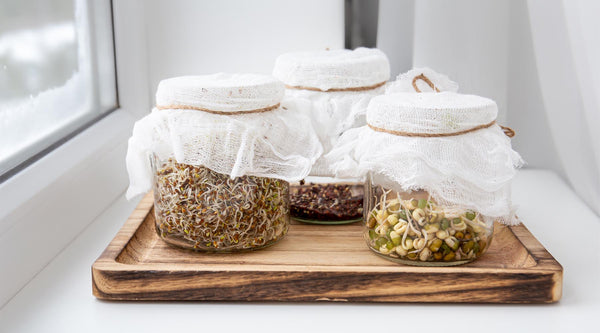
What makes microgreens different from sprouts?
Microgreens are a type of edible greens that are harvested soon after they germinate. They are usually smaller than regular greens, but they pack a powerful nutritional punch. What makes them different from sprouts is that microgreens are grown in soil or other mediums, while sprouts are just germinated seeds that haven't been grown past the sprouting stage.
Similarities
Both microgreens and sprouts are types of young plants that are grown and eaten for their nutritional value. Microgreens and sprouts are often used as a garnish or added to salads and other dishes for flavor and color. Both are typically grown indoors and can be harvested in a short t of time. Both are also high in vitamins and minerals, and both are considered to be highly nutritious.
Differences
While microgreens and sprouts are similar in some ways, there are also some key differences between the two. Here are a few of the main differences:
- Microgreens are the young seedlings of herbs, vegetables, and other plants, while sprouts are the germinated seeds of various plants.
- Microgreens are grown in soil or another growing medium. Sprouts are grown in water.
- Microgreens are harvested when they are about 1-3 inches tall, with their first true leaves. Sprouts are harvested when they are just a few days old and only have a single set of leaves.
- Microgreens have a more developed root system and a higher concentration of vitamins and minerals than sprouts.
- Microgreens have a more varied and distinct flavor than sprouts, which often have a mild, grassy flavor.
- Microgreens are typically used as a garnish or added to salads and other dishes for flavor and color, while sprouts are often eaten on their own as a snack or added to sandwiches and other dishes for a crunchy texture.
What are the most common types of microgreens?
There are many different types of microgreens that can be grown, and the most common types vary depending on personal preference and local availability. Some of the most popular types include:
- Arugula: Arugula microgreens have a spicy, peppery flavor that is similar to mature arugula leaves.
- Radish: Radish microgreens have a spicy, tangy flavor that is similar to mature radish roots.
- Broccoli: Broccoli microgreens have a mild, slightly bitter flavor and are a good source of sulforaphane, a potent antioxidant.
- Cabbage: Cabbage microgreens have a mild, slightly sweet flavor and are high in vitamins C and K.
- Kale: Kale microgreens have a slightly sweet, nutty flavor and are a good source of antioxidants and calcium.
- Pea: Pea microgreens have a sweet, pea-like flavor and are high in protein and fiber.
- Basil: Basil microgreens have a sweet, basil-like flavor and are a good source of vitamins A and C.
- Cilantro: Cilantro microgreens have a fresh, citrusy flavor and are often used as a garnish or added to salads and other dishes.
These are just a few examples of the many different types of microgreens that are available.
There are many other varieties to choose from, including mustard greens, chard, and many others.
What are the most common types of sprouts?
Some of the most common types of sprouts include:
- Alfalfa sprouts: Alfalfa sprouts are one of the most popular types of sprouts and are known for their mild, slightly sweet flavor.
- Bean sprouts: Bean sprouts are made from the germinated seeds of various beans, such as mung beans or lentils, and have a crunchy texture and a slightly nutty flavor.
- Broccoli sprouts: Broccoli sprouts are made from the germinated seeds of broccoli plants and are high in sulforaphane, a potent antioxidant.
- Radish sprouts: Radish sprouts are made from the germinated seeds of radish plants and have a spicy, tangy flavor.
- Pea sprouts: Pea sprouts are made from the germinated seeds of pea plants and have a sweet, pea-like flavor.
These are just a few examples of the many different types of sprouts that are available. Other common types of sprouts include clover sprouts, sunflower sprouts, and lentil sprouts, among others.
Which is healthier, microgreens or sprouts?
It is difficult to say which is healthier, as both microgreens and sprouts are highly nutritious and offer many health benefits. Both are good sources of vitamins and minerals, and both are high in antioxidants and other beneficial plant compounds.
However, some studies have shown that microgreens may be slightly more nutritious than sprouts. For example, one study found that microgreens had higher levels of vitamins C and E, and higher levels of antioxidants than sprouts. Another study found that microgreens had higher levels of vitamins C, E, and K, and higher levels of antioxidants, than mature lettuce leaves.
Overall, both microgreens and sprouts are highly nutritious and offer many health benefits. It is best to include a variety of both in your diet to get the most nutritional value.
Growing at Home
Both microgreens and sprouts can be easily grown at home, but some people may find one or the other to be easier to grow depending on their personal preference and the type of plants they are growing.
In general, sprouts are easier to grow than microgreens because they do not require soil or any other growing medium. All you need to grow sprouts is a jar or other container, some water, and the seeds of the plants you want to grow. Simply soak the seeds in water for a few days, and then rinse and drain them regularly until they are ready to harvest.
Microgreens, on the other hand, require soil or another growing medium to grow in, and they also require light and proper watering to thrive. While growing them at home is not difficult, it may require more attention and care than growing sprouts.
Overall, both microgreens and sprouts can be easily grown at home with the right equipment and instructions. It is a matter of personal preference and the type of plants you want to grow.
Microgreens and sprouts are both highly nutritious and offer many health benefits. They are good sources of vitamins and minerals and are high in antioxidants and other beneficial plant compounds. However, microgreens may be slightly more nutritious than sprouts. Including a variety of both in your diet is the best way to maximize the nutritional value you get from them.
Click here to shop microgreens

